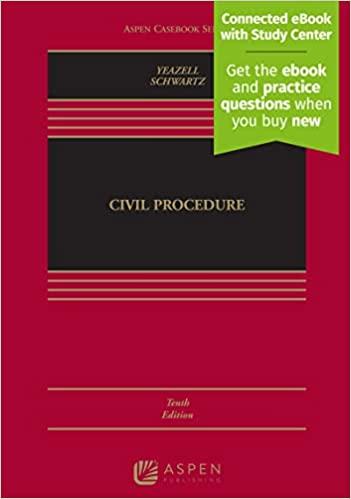Question
1. A securities market is said to be allocationally efficient if it -- a. Has the lowest transaction costs b. Has the greatest volume of
1. A securities market is said to be allocationally efficient if it --
a. Has the lowest transaction costs
b. Has the greatest volume of securities trades
c. Distributes capital evenly among market participants
d. Allocates capital to the highest and best use
2. The Securities and Exchange Commission (SEC)--
a. Is the governing board of the New York Stock Exchange
b. Was established to investigate the stock market crash of 1929
c. Is governed by five commissioners
d. Was established by the Dodd Frank Act
3. The first chairman of the SEC was--
a. Franklin Delano Roosevelt
b. Joseph P. Kennedy
c. C. Douglas Dillon
d. Theodore Roosevelt
4. Section 5 of the Securities Act --
a. Prohibits sales of unregistered securities, unless exempt
b. Establishes the SEC
c. Regulates national securities markets
d. Exempts transactions from registration requirements
5. The Securities Investor Protection Corporation (SIPC) --
a. Insures against investor trading losses
b. Insures against brokerage firm failures
c. Insures against bond defaults
d. Regulates OTC markets
6. In performing its regulatory functions, the SEC cannot issue --
a. Civil money penalties
b. Injunctions
c. Debarment orders
d. Stop trading orders
7. Which of the following is NOT a Self-Regulatory Organizations (SRO)?
a. The Securities Investor Protection Corporation (SIPC)
b. The Financial Industry Regulatory Authority (FINRA)
c. The New York Stock Exchange (NYSE)
d. The Nasdaq Stock Market (NASDAQ)
8. The Public Company Accounting Oversight Board (PCAOB) --
a. Issues binding financial accounting rules
b. Was created by the Sarbanes-Oxley Act
c. Approves registration statements
d. Was created by the Dodd Frank Act
9. The governing philosophy under the U.S. securities laws is -
a. Buyer beware
b. Disqualify doubtful or worthless securities
c. Exclude uninformed investors
d. Better inform investors
10. Which of the following is not a Congressionally-mandated objective of U.S.
securities regulation --
a. Permit businesses to raise capital
b. Facilitate securities trading
c. Ensure transparency of securities prices and trading
d. Fairly distribute financial returns
Step by Step Solution
There are 3 Steps involved in it
Step: 1

Get Instant Access to Expert-Tailored Solutions
See step-by-step solutions with expert insights and AI powered tools for academic success
Step: 2

Step: 3

Ace Your Homework with AI
Get the answers you need in no time with our AI-driven, step-by-step assistance
Get Started


